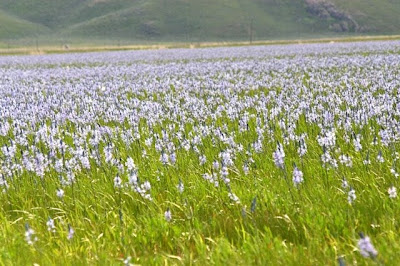 Nature Conservancy volunteer Ken Miracle sent these photos from his recent outing to the Camas Prairie and Centennial Marsh, located along Highway 20 near Fairfield.
Nature Conservancy volunteer Ken Miracle sent these photos from his recent outing to the Camas Prairie and Centennial Marsh, located along Highway 20 near Fairfield. The camas are in full bloom now, cloaking wet meadows in light blue. These beautiful meadows were also appreciated by the Lewis and Clark expedition in 1804; Meriwether Lewis described said one such meadow “resembles lakes of fine clear water.”
The camas are in full bloom now, cloaking wet meadows in light blue. These beautiful meadows were also appreciated by the Lewis and Clark expedition in 1804; Meriwether Lewis described said one such meadow “resembles lakes of fine clear water.” But the camas was more than a pretty flower for Lewis and Clark. They learned from American Indian tribes why camas bulbs were an important staple.
The bulbs were roasted in earthen ovens, and dried into cakes that could be eaten throughout the winter. Some tribes even cultivated camas. You can still ocassionally sample camas today, often at events like Camas Lily Days in Fairfield.  A great place to check out the camas bloom is the Centennial Marsh, an area The Nature Conservancy helped protect that is today a wildlife management area owned by the Idaho Department of Fish and Game.
A great place to check out the camas bloom is the Centennial Marsh, an area The Nature Conservancy helped protect that is today a wildlife management area owned by the Idaho Department of Fish and Game.
 A great place to check out the camas bloom is the Centennial Marsh, an area The Nature Conservancy helped protect that is today a wildlife management area owned by the Idaho Department of Fish and Game.
A great place to check out the camas bloom is the Centennial Marsh, an area The Nature Conservancy helped protect that is today a wildlife management area owned by the Idaho Department of Fish and Game. The Centennial Marsh is also a fantastic place for birding, especially during moist years. The marsh and surrounding areas contain large numbers of nesting waterfowl, shorebirds, sandhill cranes and raptors.
The Centennial Marsh is also a fantastic place for birding, especially during moist years. The marsh and surrounding areas contain large numbers of nesting waterfowl, shorebirds, sandhill cranes and raptors.Ken Miracle photographed the avocet (above) and northern shoveler (below) last weekend.
The flowers are peaking, so check out the Camas Prairie this weekend for a "birds and blooms" outing.

1 comment:
Beautiful pictures. I love the Camas flowers. They are stunning and I am sure the Native Americans were happy to see them every spring.
Post a Comment